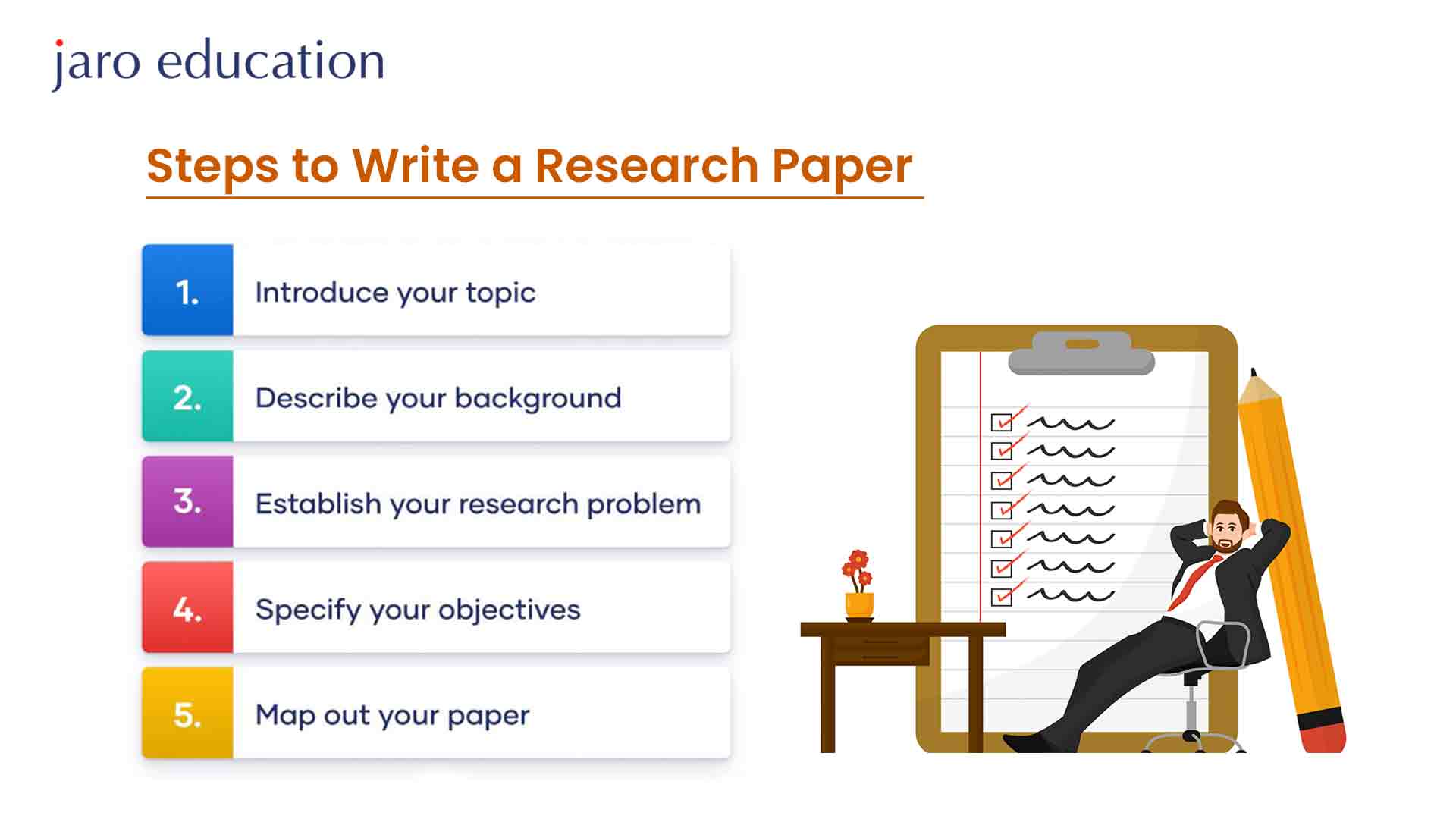How to Write and Publish a Research Paper in 7 Steps
Table of Contents

- jaro education
- 15, April 2024
- 10:00 am
Writing and publishing a research paper is indeed a crucial aspect of academic and scientific endeavors. This comprehensive guide helps you break down the process into manageable steps and offers insights into each stage. Whether you’re a student beginning your academic journey or a seasoned researcher aiming to contribute to your field, understanding these steps is essential.
What is a Research Paper?
A research paper is a scholarly document that presents the results of original research, analysis, or evaluation on a specific topic. It is a fundamental component of academic and scientific communication, allowing researchers to share their findings with the broader community.
A research paper is a written work that explores a particular subject or problem through systematic investigation and analysis. Its primary purpose is to contribute new knowledge, insights, or perspectives to the existing body of academic literature. Research papers can vary in length, structure, and format depending on the discipline, academic level, and publication requirements.
Serving as the backbone of academic and scientific progress, research papers play a crucial role in the dissemination of knowledge, fostering intellectual dialogue, and contributing to the advancement of various fields. Here are some points that depict the benefits of writing a research paper.
1. Knowledge Dissemination
One of the primary purposes of research papers is to disseminate new knowledge and findings. Through meticulous investigation and analysis, researchers generate insights that contribute to the existing knowledge body.
By publishing their work, they share these discoveries with the global academic community, enabling other scholars to build upon, critique, or expand the research.
2. Peer Review and Validation
The peer-review process is a cornerstone of scholarly publishing that ensures the quality and validity of research papers. When researchers submit their work to journals, it undergoes scrutiny by experts in the field.
This rigorous evaluation helps identify potential flaws, strengthens the methodology, and ensures that the findings are robust. Published papers, thus, gain credibility and legitimacy within the academic community.
3. Contributing to Scientific Progress
Research papers contribute significantly to the progress of science and technology. By documenting methods, results, and conclusions, researchers provide a foundation for future investigations.
Scientific progress relies on a cumulative process where each study builds upon the work of others. Consequently, research papers become building blocks that propel fields forward.
4. Promoting Academic Dialogue
Through this ongoing conversation, scholars refine their theories, challenge assumptions, and collectively push the boundaries of knowledge. Conferences, symposia, and academic journals become platforms for this dynamic exchange.
5. Educational Value
Research papers serve an educational purpose by providing valuable resources for students, educators, and aspiring researchers. Students can access a wealth of information, gain insights into research methodologies, and learn how to evaluate scientific literature critically.
6. Professional Recognition
For researchers, publishing papers is a crucial element for professional recognition and career advancement. A robust publication record is often a key metric for evaluating the impact and significance of a researcher’s contributions. It can influence hiring decisions, promotions, and funding opportunities, showcasing the researcher’s expertise and dedication to advancing knowledge.

Purpose of Writing a Research Paper
Writing a research paper holds significance as it contributes to the academic and scientific community by sharing new knowledge, advancements, and insights. It serves several purposes:
1. Knowledge Contribution
Research papers add to the existing body of knowledge, providing new information or perspectives that can benefit others in the field.
2. Communication of Ideas
It allows researchers to communicate their findings, methodologies, and interpretations to a wider audience, facilitating the exchange of ideas within the academic community.
3. Validation of Results
Through the peer-review process, research papers undergo scrutiny from experts, ensuring the validity and reliability of the findings. This contributes to the credibility of the research.
4. Building on Previous Work
Researchers often cite existing literature in their papers, demonstrating how their work builds upon or challenges prior studies. This helps in the continuous progression of knowledge.
5. Educational Value
Writing a research paper enhances a researcher’s understanding of their topic, fostering critical thinking, analytical skills, and a deeper appreciation for the research process.
6. Professional Development
Publishing research papers is crucial for researchers’ career advancement, as it establishes their expertise, visibility, and recognition within their field.
7. Problem Solving
Research papers often address real-world issues, offering potential solutions or insights. This practical application contributes to societal progress and development.
How to Write and Publish a Research Paper in 7 Steps?
In essence, the purpose of writing and publishing research papers extends far beyond individual accomplishments. These documents are essential tools for sharing knowledge, validating scientific findings, fostering academic dialogue, contributing to progress, and shaping the educational landscape. By embracing these purposes, researchers collectively propel their fields forward, enriching the global tapestry of human understanding.
1. Select a Relevant Topic
Choose a topic that aligns with your interests and expertise. Ensure it’s relevant to your field of study and contributes to existing knowledge. Conduct a literature review to understand the existing research and identify the gaps your paper will address.
2. Develop a Clear Research Question or Hypothesis
Formulate a focused research question or hypothesis that your paper aims to answer. Clearly define the objectives and scope of your study. This provides a roadmap for your research and helps maintain a coherent structure throughout the paper.
3. Plan and Conduct Rigorous Research
Design a well-thought-out research methodology that suits your question or hypothesis. Collect data using appropriate methods and tools. Ensure the reliability and validity of your findings. Organize your data effectively, making it ready for analysis.
4. Write a Solid Introduction
Craft an engaging introduction that provides background information, states the research problem, and outlines your objectives. Clearly articulate the significance of your study and how it contributes to the existing body of knowledge. End the introduction with a concise thesis statement.
5. Structure a Well-Organised Body
Divide the main body of your paper into sections such as literature review, methodology, results, and discussion. Present your findings logically, supported by evidence. Interpret the results and relate them to your research question or hypothesis. Maintain a coherent flow of ideas throughout.
6. Craft a Thoughtful Conclusion
Summarise your key findings and their implications. Revisit your research question or hypothesis and discuss whether they were answered or supported by your results. Highlight the contributions of your study and suggest avenues for future research. Conclude with a strong, memorable statement.
7. Prepare for Publication
Review and revise your paper thoroughly. Ensure clarity, coherence, and adherence to formatting guidelines. Seek feedback from peers or mentors. Once satisfied, submit your paper to a reputable journal in your field. Follow the journal’s submission guidelines and be prepared to address reviewers’ comments.
Understanding The Key Components of Research Papers
Writing a research paper involves several key components that contribute to the overall quality and effectiveness of the document. From the initial stages of selecting a topic to the final steps of citation and proofreading, each component plays a crucial role in producing a well-researched and well-written paper.
1. Title
The title is the first impression of a research paper. It should be concise yet informative, providing readers with a glimpse into the study’s focus. A compelling title is crucial for attracting attention and conveying the essence of the research.
2. Abstract
The abstract is a brief summary of the entire research paper, offering a snapshot of the research question, methodology, results, and conclusions. Its brevity makes it a valuable tool for researchers and scholars to assess the paper’s relevance to their interests quickly.
3. Introduction
The introduction sets the stage for the research by presenting the background, context, and the research question or hypothesis. It should establish the significance of the study, provide a brief literature review, and outline the paper’s structure.
4. Literature Review
The literature review surveys existing scholarly works related to the research topic. It helps contextualize the study, identifies gaps in current knowledge, and justifies the need for the research. A well-executed literature review demonstrates the researcher’s familiarity with relevant studies.
5. Methodology
The methodology section details the research design, data collection methods, and data analysis techniques. It should be clear and precise, allowing other researchers to replicate the study. Whether qualitative or quantitative, the methodology is the blueprint that ensures the study’s rigor.
6. Results
Presenting the findings in a clear and organized manner is the primary objective of the results section. Tables, graphs, and descriptive text are commonly used to convey the data. This section should avoid interpretation and focus solely on presenting the research outcomes.
7. Discussion
In the discussion section, researchers interpret their findings, relate them to the existing literature, and explore the implications of the results. It is an opportunity to critically analyze the study’s limitations, acknowledge potential biases, and suggest avenues for future research.
8. Conclusion
The conclusion offers a concise summary of the key findings and their significance. It should restate the research question or hypothesis and emphasize the study’s contribution to the field. Avoid introducing new information in the conclusion.
9. References
The references section provides a comprehensive list of all sources cited in the research paper. Proper citation is crucial for academic integrity and allows readers to explore the referenced works for further understanding. See below why citation is significant while writing research papers.
10. Acknowledgements
Researchers often include an acknowledgment section to express gratitude to individuals or institutions that contributed to the research but may not be listed as co-authors.
Citation Styles Used in Research Paper Writing
Citing sources accurately is a crucial aspect of academic writing, ensuring proper acknowledgment of borrowed ideas and information. Different disciplines and institutions may follow specific citation styles, each with its unique guidelines.
1. APA (American Psychological Association)
- Widely used in the social sciences, the APA style emphasizes clarity and conciseness.
- In-text citations include the author’s name and the publication year.
- The references list at the end provides full details of the sources cited.
2. MLA (Modern Language Association)
- Commonly employed in humanities, especially literature and language studies.
- In-text citations include the author’s last name and page number.
- Works Cited page details full bibliographic information.
3. Chicago/Turabian
- Used in history and some other disciplines, with Chicago being more common for book and journal publications.
- Offers two citation styles: notes-bibliography, and author-date.
- Footnotes or endnotes are used for in-text citations in the notes and bibliography style.
4. IEEE (Institute of Electrical and Electronics Engineers)
- Predominantly used in technical fields, such as engineering and computer science.
- In-text citations are numbered to correspond to the full citation in the reference list.
5. Harvard
- Harvard style uses the author-date system and is employed in various disciplines,
- In-text citations include the author’s name and the publication year.
- The reference list provides complete details.
6. AMA (American Medical Association)
- Common in medical and scientific research papers.
- In-text citations are numeric, corresponding to the numbered references in the bibliography.
7. ACS (American Chemical Society)
- Primarily used in chemistry-related disciplines.
- Employs a numbered citation system with superscript numbers in the text.
- References are listed numerically at the end.
8. CSE (Council of Science Editors)
- Applied in various scientific disciplines.
- Offers three systems: citation-sequence, name-year, and citation-name.
- In-text citations and the reference list format vary based on the chosen system.
The Significance of Citation Style
Citation style plays a pivotal role in the academic landscape, particularly in the realm of research papers. Its importance cannot be overstated, as it serves multiple purposes that contribute to the credibility, clarity, and ethical foundation of scholarly work. Let’s look at the reasons why citation is important.
1. Acknowledging Intellectual Debt
Citations are not just a formality but a means of acknowledging intellectual debt. When a researcher builds upon existing knowledge or draws inspiration from previous works, proper citation gives credit to the original authors. This not only respects the intellectual property of others but also demonstrates the researcher’s commitment to academic integrity.
2. Ensuring Credibility and Trustworthiness
A well-cited paper enhances its credibility. By referencing established sources, a researcher demonstrates a solid foundation for their arguments and positions within the scholarly discourse. This not only adds weight to their claims but also allows readers to trace the origins of information, fostering transparency and trust in the research.
3. Avoiding Plagiarism
Plagiarism is a serious academic offense that can have severe consequences. Citation style serves as a safeguard against unintentional plagiarism by providing a systematic way to attribute ideas and words to their rightful owners. It ensures that a researcher’s work is a genuine contribution to the field and not an unethical appropriation of others’ intellectual property.
4. Facilitating Reproducibility
Researchers often build upon the work of their peers to advance knowledge. Accurate and comprehensive citations enable readers to trace the steps of a study, facilitating the replication and verification of research findings. This transparency is crucial for the scientific community to validate and build upon existing knowledge.
5. Establishing a Standardised Format
Different academic disciplines have distinct citation styles, such as APA, MLA, or Chicago. Adhering to a specific citation style ensures a standardized format, making it easier for readers, reviewers, and fellow researchers to navigate and understand the structure of a research paper. Consistency in citation style adds professionalism to the work.
6. Enhancing Readability and Clarity
Proper citation contributes to the overall readability and clarity of a research paper. It enables readers to follow the flow of ideas and easily locate the sources that support or challenge the presented arguments. A well-cited paper reflects a meticulous approach to research and writing, enhancing its overall quality.
7. Encouraging Academic Dialogue
Citation style is not just a technical aspect; it is also a tool for engaging in academic dialogue. By citing relevant literature, researchers participate in a larger conversation within their field. This interplay of ideas and perspectives contributes to the dynamic nature of academic discourse, fostering intellectual growth and collaboration.
Conclusion
Remember, writing and publishing a research paper requires patience and persistence. Embrace feedback as an opportunity for improvement, and be prepared to revise and resubmit. With diligence and attention to detail, your research can make a valuable contribution to your academic field.
If you are willing to pursue a Doctorate in Business Management course, the Swiss School of Management is the ideal place to enroll. By means of digital support and high-quality, intensive supervision, participants get to focus on diverse business and academic trajectories. That’s not all; you get to learn from the top 1% of industry and academia experts with experience in multiple domains.









